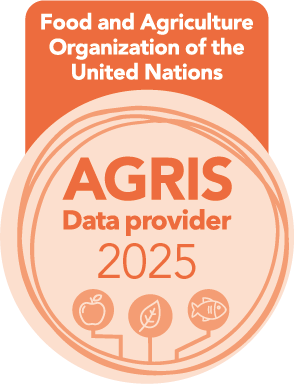Unearthing the Knowledge of Natural Farming through Content Analysis of English YouTube Videos
DOI:
https://doi.org/10.26725/JEE.2022.4.34.6910-6919Keywords:
Social Media; Agricultural Videos; YouTube; Natural Farming; Content Analysis; Intra-Coder Reliability.Abstract
Amidst the vast realm of digital content, YouTube covers agricultural videos that exhibit the marvels of natural farming. This content analysis, conducted in 2023, encompasses a comprehensive synopsis of YouTube videos communicated in English on natural farming. By employing a meticulously prepared checklist, the study delved into both qualitative and quantitative aspects of the videos. A total of 150 videos were selected through systematic random sampling, assuring recurrent themes and subthemes. An accurate and consistent analysis was ensured by conducting intra-coder reliability. The analysis includes categorization in respect oftype of enterprise, type of crop, place of program, shot type, Type of operational practices, type of manure, type of mulching, type of compost, type of soil water conservation techniques, type of pest management techniques, the theme of the channels, number of subscribers, and type of content. The analysis focused on YouTube’s coverage of promoting knowledge about natural farming practices by serving as a comprehensive resource for empowering and motivating people on their sustainable agricultural journeys.References
Albahiri, M. H., & Alhaj, A. A. M. (2020). Role of Visual Element in Spoken English Discourse: Implications for YouTube Technology in EFL Classrooms. The Electronic Library, 38, 531-544.
Andres, D., & Woodard, J. (2013). Social media handbook for agricultural development practitioners. USAID and FHI 360. http://ictforag.org/toolkits/social/SocialMedia4AgHandbook.pdf.
Berelson, Bernard. (1952). Content analysis in communication research. New York: Hafner.
Berk, R. (2009). Multimedia teaching with video clips: TV, movies, YouTube, and mtvU in the college classroom. International Journal of Technology in Teaching and Learning, 5(1),1-21.
Bo-Kristensen, M., Ankerstjerne, N. O., Neutzsky-Wulff, C., & Schelde, H. (2009). Mobile City and Language Guides--New Links between Formal and Informal Learning Environments. Electronic Journal of e-Learning, 7(2), 85-92.
Bower, G. H. (1972). Analysis of intra-coder reliability. Psychological Bulletin, 77(6), 829-849.
Chmielewski (2011) as quoted in Cohen, H. 2011. 30 social media definitions. Retrieved from http://heidicohen.com/social-mediadefinition
Green, S. M., Voegeli, D., Harrison, M., Phillips, J., Knowles, J., & Weaver, M.. (2003). Evaluating the Use of Streaming Video To Support Student Learning in a First-Year Life Sciences Course for Student Nurses. Nurse Education Today, 23(4), 255-261.
Merriam-Webster. (2015) Social media. Retrieved from http://www.merriam-webster.com/social-media
Mitra, B., Lewin-Jones, J., Barrett, H., & Williamson, S. (2010). The Use of Video to Enable Deep Learning. Research in Post- Compulsory Education, 15(4), 405-414.
Morrissey, K. A. (1991). Interactive Video and Informal Learning Environments. In Proceedings of Selected Research Presentations at the Annual Convention of the Association for Educational Communications and Technology. (pp. 1-13).
Haradakis, P., & Hanson, G. (2009). Social interaction and co-viewing with YouTube: Blending mass communication reception and social connection. Journal of Broadcasting & Electronic Media, 53(2), 317-335.
Jina, J., Steel, G., & Fine, A. (2012). The impact of mass media campaign on promoting physical activity among the general population: A systematic review. American Journal of Health Promotion, 26(5), e149-e158.
Kalusopa, T. (2005). The Challenges of Utilising Information and Communication Technologies (ICT’s) for the Small Scale Farmer in Zambia. Library Technology, 23(3), 2006.
Lewis, P. M., (1997). Video in Non-Formal Education: A Bibliographical Study. UNESCO.
Muyanga, M., & Jayne, T. S. (2006). Agricultural extension in Kenya: Practice, policy and lessons. Tegemeo Institute of Agriculture and Policy Development, Egerton University.
Reynolds, P. A., & Mason, R. (2002). On-line video media for continuing professional development in dentistry. Computers & Education, 39(1), 65.
Sandhu, H. S., Singh, G., & Grover, J. (2012). Analysis of kisan mobile advisory in south western Punjab. Journal of Krishi Vigyan, 1-4, 25-28.
Saravanan, R., & Bhattacharjee, S. (2014). Social media: New generation tools for agricultural extension? Retrieved from http://www.aesagfras.net/Resources/file/Saravanan%20Final%20blog%2042.pdf
Singh, G., Singh, P., & Sodhi, G. P. S. (2017). Assessment and analysis of agriculture technology adoption and yield gaps in wheat production in sub-tropical Punjab. Indian Journal of Extension Education, 53(1), 70-77.
Snelson, C., & Perkins, R. A. (2009). From silent film to YouTube™: tracing the historical roots of motion picture technologies in education. Journal of visual literacy, 28(1),1-27.
Wimmer, R. D., & Dominick, J. R. (2005). Mass media research: An introduction. Cengage Learning.
Downloads
Published
How to Cite
Issue
Section
License
Copyright (c) 2022 https://creativecommons.org/licenses/by-nc-sa/4.0/

This work is licensed under a Creative Commons Attribution-NonCommercial-ShareAlike 4.0 International License.
Authors who publish with JEE agree to the following terms:
- Authors retain copyright and grant JEE right of first publication with the work simultaneously licensed under a Creative Commons Attribution License that allows others to share the work with an acknowledgement of the work's authorship and initial publication in this journal.
- Authors are able to enter into separate, additional contractual arrangements for the non-exclusive distribution of the journal's published version of the work (e.g., post it to an institutional repository or publish it in a book), with an acknowledgement of its initial publication in this journal.
- Authors are permitted and encouraged to post their work online (e.g., in institutional repositories or on their website) prior to and during the submission process, as it can lead to productive exchanges, as well as earlier and greater citation of published work (See The Effect of Open Access).
Extension Education Society
https://creativecommons.org/licenses/by-nc-sa/4.0/
This work is licensed under a Creative Commons Attribution-NonCommercial-ShareAlike 4.0 International License.













.png)

